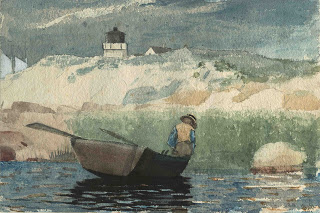
I never knew much about watercolor as a technique other than the fact that its early association with amateur painters had prejudiced many art historians, collectors and museums not to treat it sufficiently seriously. Still I recognize major accomplishment when I see it and Winslow Homer is unquestionably at the summit of the field. Sorry to say I didn’t get to the Art Institute of Chicago to see their major exhibition this Spring but fortunately the catalog came my way (Watercolors by Winslow Homer; the color of light ISBN 970-0-300-11954-9).
Written by Martha Tedeschi (with colleagues Kristi Dahm and Judy Walsh), the volume is neither limited to the exhibition nor directed only at specialists; everyone who paints in watercolors or likes looking at them will find it an invaluable resource as well as a joy to peruse. For in addition to several historical essays about Homer as a watercolorist, it ‘s interspersed with double-page spreads, beautifully-illustrated with photographic details, that form a glossary of all the terms associated with watercolors. These include terms describing the paper and its effects (twill paper, textural effects), the paint (transparent watercolor, watercolor boxes and cakes), methods of manipulating the paint (spattering, wet scraping, blotting), modern means of studying watercolors (ultraviolet examination) and the major problems that befall the paintings with time (fading, mold).
A fascinating article by Judy Walsh documents the influence of Chevreul’s color theory on Homer’s watercolors; it even illustrates the drawing of the aged Chevreul which the artist pasted into his copy of Chevreul on Colors (the English translation of 1859). The scientific analysis of color was of great and documented interest to nineteenth-century painters; there might finally be a rational way to discuss the crucial but intangible subject. The best-known example of Chevreuls’s influence on painting is the work of Seurat which the Art Institute explored in an earlier exhibition and catalog, Seurat and the Making of ‘La Grande Jatte’ (2004). Walsh analyzes the effects that the self-taught Homer achieved through his careful study of this important color theorist who had such an impact on the most advanced painters of the day.
The volume is also beautifully produced and sensitively designed by Studio Blue (Chicago) who paid enough attention to the subject to approximate certain watercolor effects in the table of contents and chapter dividers; it is rare that text has such meaning beyond the words it forms. This book belongs in the libraries of painters and watercolor enthusiasts and would make a beautiful gift.









